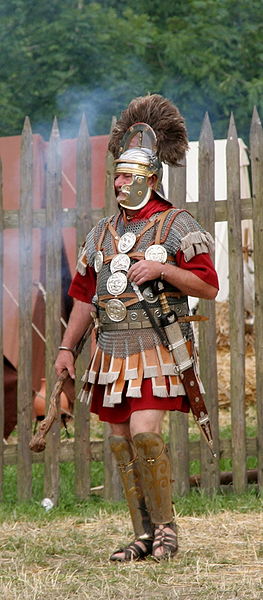|
Welcome to the PILUM Quarterly Journal ~ Issue IX ~ JUN 2762 AUC (2009 CE)
Insight on the Roman military machine! The Pilum is a quarterly webzine publication and the official newsletter of the Sodalitas Militarium of Nova Roma, providing articles, stories and discussions on various aspects of the Roman Military with a special focus on Infantry, Cavalry, Naval, Engineering and Cartography topics.
| ||
|
Pilum Cohors
|
From the Editor's Desk Have an interesting article or series you would like to share with others on ancient Rome? Send us your works for preview for inclusion in the next issue of the Pilum today! Inquiries and contributions for publication consideration may be sent to this webzine via the Managing Editor at:
In This Issue... Article I[]A Tough Decision ~ Part I: Brenda Ralph Lewis, Caesar’s Battle For Britannia, Military History Magazine, Primedia, Publisher As the late summer sun drew lower in the sky over the northern coast of Gaul (modern France) the lone figure of Gaius Julius Caesar stood in contemplation looking out over the wide stretch of “Oceanus” that separated him from the mysterious island that he could just make out lying just beyond his reach, but neither his sight or desire. More... Article II[]Roman Conquest of Iberia ~ Part I: Richard K. Munro, Roman Conquest Of Spain, Military History Magazine, (June, 2000), Pages 32-36 One of the most decisive wars in ancient history was the result of the conquest of Iberia by General Hannibal Barca from Carthaginia. This conquest did much to foment and start the Second Punic War (219 - 202 BC). More... Article III[]Marcus Furius Camillus: Drew J. Kendall, Marcus Furius Camillus—The Roman Republic’s Greatest Champion Or Merely A Literary Legend?, Military History Magazine, Nov. 2005, Pages 12, 14, & 18. At the gates of Rome a very familiar figure alone, disgraced, and without escort stumbled through the great gates and made his way down the road to exile. This man was Marcus Furius Camillus, once dictator, three time Roman military tribune, and recently the Roman Commander of an impressive victory, probably the most impressive one of the Republic in its early years. More... Article IV[]Some Aspects of the Hydraulic Design of Roman Aqueducts: Hubert Chanson, Some Aspects of the Hydraulic Design of Roman Aqueducts, La Houille Blanche, 2002, No, 6/7, pp. 43-57 (in French), http://www.uq.edu.au/”e2hchans/TRAIANYS. The marvelous architectural works were not only easy to look at, but they were also build for long term usage. In some places they still carry water to needy communities a thousand years an more after they were constructed. They were essentially extensive supply systems for war usage on a daily basis as well as the storage of water for times of need. More... Article V[]Roman Marine II: Audens, Marcus. The floor of the passage was dry, and the atmosphere was both cool and damp. The way was dark and lighted only by the reflected light from the lamps in the rooms he passed. He saw several small offices that were set off the tunnel-way which were filled with scribae and librarii laboring over piles of ledgers and stacks of papyri and parchment. This was obviously the administrative heart of the fortress at Dubris. More... Article VI[]Marcus Aurelius ~ Book II, Item II: Marcus Aurelius, Martin Hammond (Trans.), Meditations, Penguin Books, New York - London, 2006, Pg. 11. Marcus Aurelius' writings on keeping personal observances. More... Article VII[]Mago Barca, Brother of Hannibal: Compiled from Wikipedia.org, Livius.org Mago Barca (Phoenician Meaning: "God sent"), son of Hamilcar Barca, also spelled Magon (243 BC - 203 BC), was a member of the Barcid family, and played an important role in the Second Punic War, leading forces of Carthage against the Roman Republic in Hispania, Gallia Cisalpina and Italy. More... Article VIII[]Cyrenaica ~ The Romans in Libya: Compiled from Wikipedia.org, Livius.org In the ancient world Cyrenaica was originally occupied by a semi-nomadic population conventionally known as Libyan, and settled by Greek colonists in and after the late seventh century BCE. The Greeks eventually established five cities (Cyrene, Apollonia, Barca/Ptolemais, Taucheira and Euhesperides/Berenice) and an unknown number of villages. More... Article IX[]Sodalitas Militarium ~ Standing Orders: Current Standing Orders of the organization, listing the current Praefectures and appointments within the Militarium, Officers and Responsibilities of the Militarium Staff, and Sodalitas Militarium Web list Rules. More...
| |
Bibliotheca
|
| |||
Copyright© 2001-2009. Sodalitas Militarium of Nova Roma.


